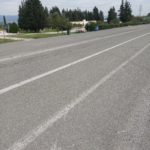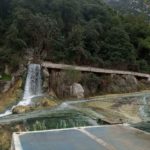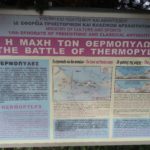The location of Leonidas’s tomb remains a subject of historical intrigue and debate. Historical records suggest that he was buried near Thermopylae, but the exact spot is unknown. Efforts have been made in recent years to locate his tomb, with archaeologists and historians studying ancient texts, conducting excavations, and exploring potential burial sites near Thermopylae.
Key Takeaways:
- Leonidas’s burial site is still unknown, despite historical records suggesting it was near Thermopylae.
- Archaeologists and historians have been actively searching for his tomb.
- Ancient texts and excavations have been used to study potential burial sites.
The Battle of Thermopylae and the Last Stand of Leonidas
The Battle of Thermopylae stands as a testament to the bravery and resilience of Leonidas and his Spartan warriors. This historic conflict, fought between the Greek city-states and the Persian Empire, is etched into the annals of military history as a defining moment of heroism. Facing overwhelming odds, Leonidas and his 300 Spartans made their famous last stand at the narrow pass of Thermopylae.
“Go, stranger, and to Lacedaemon tell
That here, obedient to her laws, we fell.”
The Persian army, numbering in the hundreds of thousands, sought to invade Greece. In a strategic move, Leonidas and his warriors positioned themselves at the pass, utilizing its narrowness as a force multiplier. For three days, they held their ground against wave after wave of Persian attacks, inflicting heavy casualties and repelling the invaders with unwavering determination.
Despite their ultimate defeat, the Battle of Thermopylae galvanized the Greek city-states and inspired a sense of unity and defiance against the Persian Empire. It bought the Greeks valuable time to prepare for the incoming Persian invasion, which eventually led to their victory in the larger conflict. The heroism displayed by Leonidas and his Spartans remains an enduring symbol of courage, sacrifice, and the indomitable spirit of resistance.
Legacy and Inspiration
The Battle of Thermopylae has continued to captivate the imagination of people around the world. It has been immortalized in literature, art, and popular culture, serving as a timeless reminder of the power of determination in the face of overwhelming odds. Leonidas and his legendary last stand have inspired countless individuals, igniting a flame of courage and resilience that burns brightly even to this day.
Table: Key Facts about the Battle of Thermopylae
| Event | Date | Location |
|---|---|---|
| The Battle of Thermopylae | 480 BCE | Thermopylae, Greece |
| Main Combatants | Greek city-states (led by Leonidas and the Spartans) vs. Persian Empire | |
| Outcome | Greek defeat, but bought time for Greek city-states to prepare for larger conflict | |
| Significance | Inspired Greek unity, showcased Spartan heroism, and slowed Persian invasion |
Conflicting Accounts of Leonidas’s Burial
Various accounts from antiquity offer conflicting information about the burial of Leonidas. Pausanias, an ancient traveler, states that Leonidas was buried in a tomb at Thermopylae. However, another account suggests that his remains were returned to Sparta, where a monument in his honor was erected. The tomb of Leonidas may have been destroyed or lost to history over time.
These conflicting accounts highlight the challenges faced by historians and archaeologists in uncovering the truth about Leonidas’s burial. Ancient texts often provide incomplete or contradictory information, leaving room for interpretation and speculation. The passage of time and the destruction of historical sites further complicate the search for definitive answers.
“Pausanias’s account of Leonidas’s burial at Thermopylae is a significant piece of evidence regarding the location of his tomb,” says Dr. Maria Papadopoulou, a historian specializing in ancient Greek history. “However, the absence of physical evidence makes it difficult to conclusively determine the exact spot where Leonidas was laid to rest.”
Exploring Burial Customs in Ancient Greece
To better understand the possible fate of Leonidas’s tomb, it is important to consider the burial customs of ancient Greece. In ancient times, burial practices varied from region to region and could be influenced by factors such as social status and religious beliefs.
In Sparta, for example, it was customary to bury individuals within the city walls to honor their contributions to the state. However, the remains of prominent figures were sometimes returned to their hometowns for burial or commemorated with monuments.
The case of Leonidas’s burial demonstrates the complexities of uncovering the truth about historical events and figures. As researchers continue to investigate and analyze available evidence, the mystery surrounding the final resting place of Leonidas remains unsolved.
| Conflicting Accounts | Pausanias’s Account | Alternative Account |
|---|---|---|
| Location of Burial | Thermopylae | Sparta, with a monument erected in his honor |
| Reliability | Considered significant evidence | Raises questions due to lack of physical evidence |
| Historical Challenges | Time and destruction of historical sites | Interpretation and speculation due to conflicting accounts |
The Legacy of Leonidas and the Battle of Thermopylae
Leonidas, the fearless leader of the 300 Spartan warriors, left behind a powerful legacy that continues to inspire generations. His heroic stand at the Battle of Thermopylae showcases the epitome of courage, determination, and sacrifice in the face of overwhelming odds. The story of Leonidas and his Spartan warriors has become synonymous with heroism and serves as a reminder of the indomitable human spirit.
The Battle of Thermopylae, although ended in defeat for the Spartans, holds immense historical significance. It served as a turning point in the Greco-Persian Wars and bought crucial time for the Greek city-states to prepare themselves for the larger conflict. Leonidas and his brave warriors fought valiantly for three days, inflicting heavy casualties on the Persian army. Their unwavering determination and refusal to surrender have become legendary.
Leonidas’s legacy extends far beyond the battlefield. His story has inspired countless individuals and continues to resonate in popular culture. Movies, books, and other forms of media portray his heroism, ensuring that his legacy lives on. The Battle of Thermopylae has become a symbol of resistance and the willingness to fight for what is right, even against insurmountable odds. Leonidas’s example serves as a testament to the power of courage and the human spirit.
Exploring Sparta: Traces of Leonidas’s History
When visiting the city of Sparta, there are several fascinating places where visitors can immerse themselves in the rich history of Leonidas. One of the must-visit locations is the Archaeological Museum of Sparta. Here, visitors can marvel at rare exhibits from ancient and Roman times, including exquisite sculptures and architectural remnants. The museum offers a captivating journey through time, providing valuable insights into the culture and civilization that Leonidas and his Spartan warriors belonged to.
As you wander through the streets of Sparta, you’ll come across a remarkable landmark – the statue of Leonidas. This imposing statue stands proudly in the central street, serving as a powerful tribute to the legendary king and his heroic last stand at Thermopylae. It’s a poignant reminder of the indomitable spirit and unwavering courage displayed by Leonidas and his fellow Spartans.
For those seeking to delve deeper into the history of Leonidas, the Tomb of Leonidas is an essential visit. Located in Sparta, this temple-shaped building is said to be the final resting place of the renowned king. Explore the sacred grounds and reflect on the legacy of Leonidas, as you pay homage to his memory. While the exact location of his burial site remains uncertain, this monumental tomb reminds us of the enduring impact he had on history.
Sparta’s Rich History: A Glimpse into the Past
As you explore the city of Sparta, take the time to appreciate the broader historical context surrounding Leonidas. Learn about the fascinating customs, traditions, and way of life that characterized ancient Sparta. Alongside the notable sites associated with Leonidas, the city boasts the Museum of Olive and Greek Olive Oil, which showcases the significance of the olive tree and olive oil in Greek culture. The museum provides a unique insight into the ancient practices, techniques, and legacy of olive cultivation.
The Acropolis of Sparta is another captivating attraction that offers panoramic views of the city. Wander through the ancient theater, imagine the performances that once took place here, and marvel at the scale and beauty of the surrounding ruins. Don’t miss the opportunity to visit the Sanctuary of Artemis Orthia, an archaeological site that offers further insights into the religious practices and beliefs of ancient Sparta.
Just a short distance from Sparta lies Mystras, a UNESCO World Heritage Site that provides a glimpse into the medieval past. Explore the well-preserved ruins of this once-thriving Byzantine town, admire the impressive architecture, and soak in the rich history that permeates every corner. Mystras offers a fascinating contrast to the ancient Spartan civilization and provides a deeper understanding of the region’s layered history.
| Attraction | Description |
|---|---|
| Archaeological Museum of Sparta | A collection of rare exhibits from ancient and Roman times, including sculptures and architectural remnants. |
| Statue of Leonidas | An imposing statue in the central street, serving as a tribute to Leonidas and his heroic last stand. |
| Tomb of Leonidas | A temple-shaped building said to be the final resting place of the renowned king. |
| Museum of Olive and Greek Olive Oil | Showcases the significance of the olive tree and olive oil in Greek culture. |
| Acropolis of Sparta | An ancient site offering breathtaking views of the city and featuring an ancient theater and the Sanctuary of Artemis Orthia. |
| Mystras | A UNESCO World Heritage Site with well-preserved medieval ruins to explore. |
Other Notable Attractions in Sparta
While exploring the historical sites associated with Leonidas in Sparta, there are also other notable attractions that visitors can enjoy. These attractions offer a glimpse into the rich history and culture of this legendary city.
Museum of Olive and Greek Olive Oil
The Museum of Olive and Greek Olive Oil is a must-visit for those interested in Greek culture and history. This unique museum showcases the significance of the olive tree and olive oil throughout the centuries. Visitors can explore exhibits that highlight the cultivation of olives, the extraction process, and the importance of olive oil in ancient and modern Greece. The museum offers a fascinating insight into the role of olives and olive oil in Greek cuisine, culture, and economy.
Acropolis of Sparta
Perched on a hill overlooking the city, the Acropolis of Sparta offers a breathtaking view and a glimpse into the city’s ancient past. Visitors can explore the ruins of the ancient theater, which was once a center of cultural and social activities. The Sanctuary of Artemis Orthia, an important religious site dedicated to the goddess Artemis, is also located within the Acropolis. This sacred place provides a fascinating insight into the religious practices of ancient Sparta.
Mystras
Just a short distance from Sparta lies the UNESCO World Heritage Site of Mystras. This medieval fortified town offers a captivating journey through time. Visitors can wander through the labyrinthine streets, explore the ruins of the palaces, churches, and monasteries, and marvel at the stunning frescoes that adorn the walls. Mystras allows visitors to immerse themselves in the history and architectural beauty of this once-thriving Byzantine city.
| Attraction | Description |
|---|---|
| Museum of Olive and Greek Olive Oil | Explore the significance of the olive tree and olive oil in Greek culture, cuisine, and economy. |
| Acropolis of Sparta | Enjoy a panoramic view of the city and discover the ancient theater and the Sanctuary of Artemis Orthia. |
| Mystras | Step back in time at this UNESCO World Heritage Site and explore the medieval ruins of palaces, churches, and monasteries. |
Outdoor Excursions: Taygetus Mountain and Surrounding Villages
When visiting Sparta, exploring the scenic beauty of Taygetus Mountain and its surrounding villages is a must for nature enthusiasts and adventure seekers. The mountain offers idyllic paths for hiking, hidden villages waiting to be discovered, and a taste of delicious local cuisine in the charming taverns and restaurants scattered along the routes.
Split into South and North, Taygetus Mountain presents distinct highlights for visitors to enjoy. In the South, you can marvel at the breathtaking gorge that cuts through the landscape, offering awe-inspiring views of the surrounding valleys. As you traverse the trails, make sure to stop by the picturesque villages of Arna and Koumousta, where time seems to have stood still. Immerse yourself in the rustic charm and soak in the warm hospitality of the locals, who are always eager to share stories about their heritage and traditions.
For those looking for a spiritual experience, a visit to the famous Monastery of Gola is a must. Perched on the slopes of Taygetus Mountain, this centuries-old monastery offers a tranquil retreat where you can connect with your inner self and admire the beautiful frescoes and religious artifacts that adorn its walls. The monastery also offers stunning panoramic views of the surrounding landscapes, providing the perfect backdrop for reflection and contemplation.
Taygetus Mountain and Surrounding Villages: A Nature Lover’s Paradise
Whether you’re an avid hiker or simply seeking a peaceful escape into nature, Taygetus Mountain and its surrounding villages will captivate your senses. The rugged beauty of the mountain, combined with the genuine hospitality of the local communities, creates an unforgettable experience that will leave you longing to return. So pack your hiking boots, grab your camera, and immerse yourself in the natural wonders that await in the heart of Sparta.
Conclusion
The location of Leonidas’s tomb may remain unknown, but the historical significance of his actions and the Battle of Thermopylae cannot be overstated. This legendary battle, where Leonidas and his Spartan warriors fought valiantly against overwhelming odds, has become a symbol of courage and determination.
In the city of Sparta, visitors can immerse themselves in the rich history and culture associated with Leonidas. From the Archaeological Museum, housing ancient exhibits, to the statue of Leonidas proudly standing in the central street, there are plenty of opportunities to explore his legacy.
While we may never find the exact burial place of Leonidas, his memory lives on through the enduring power of heroism and the inspiration it provides to generations. Sparta’s rich history and the story of Leonidas and the Battle of Thermopylae continue to captivate and inspire visitors from around the world.
FAQ
Where is the tomb of Leonidas located?
The exact location of Leonidas’s tomb remains unknown. Historical records suggest it may be near Thermopylae, but efforts to locate it have been inconclusive.
What was the Battle of Thermopylae?
The Battle of Thermopylae was a significant conflict in the Greco-Persian Wars. Leonidas and his 300 Spartan warriors defended the pass of Thermopylae against the Persian army, buying valuable time for the Greek city-states to prepare for the larger conflict.
Are there conflicting accounts of Leonidas’s burial?
Yes, various accounts from antiquity offer different information. Some suggest he was buried at Thermopylae, while others believe his remains were returned to Sparta for a monument in his honor.
What is the legacy of Leonidas and the Battle of Thermopylae?
Leonidas and the Battle of Thermopylae have become symbols of courage, sacrifice, and the indomitable spirit of resistance. The story continues to inspire people worldwide, highlighting the power of heroism and determination.
What historical sites in Sparta are associated with Leonidas?
Visitors to Sparta can explore the Archaeological Museum, which houses exhibits from ancient times. The city also features a statue of Leonidas and the Temple-shaped Tomb of Leonidas.
Are there other attractions in Sparta besides those related to Leonidas?
Yes, the Museum of Olive and Greek Olive Oil showcases Greek culture, and the Acropolis of Sparta offers breathtaking views and ancient ruins. Mystras, a UNESCO World Heritage Site, is a short distance away with medieval ruins to explore.
What outdoor excursions are available in Sparta?
Nature lovers can explore the scenic beauty of Taygetus Mountain, with idyllic paths, hidden villages, and local cuisine to enjoy. The gorge, villages of Arna and Koumousta, and the Monastery of Gola are highlights.
Where is Leonidas’s burial place?
The exact location of Leonidas’s tomb remains a mystery. While efforts have been made to locate it near Thermopylae, its precise whereabouts have not been confirmed.
Source Links
- https://www.pakistantraveler.com/leonidas-tomb/
- https://www.ancient-origins.net/history/king-leonidas-sparta-and-legendary-battle-300-thermopylae-002848
- https://greektraveltellers.com/blog/sparta-things-to-do-and-see
Author Profile
-
Welcome to e-thermopyles.gr, your gateway to the fascinating world of Thermopylae and the legendary Spartans. My name is George Margaritis, and I’m the proud owner and writer behind this website.
A Passion for History and the Spartan Legacy
I consider myself fortunate to call the historic site of Thermopylae my home. From a young age, I was captivated by history, and in particular, the incredible tale of the Battle of Leonidas in Thermopylae. The valiant stand of King Leonidas and his 300 Spartans against overwhelming odds has left an indelible mark on the annals of history.
As I delved deeper into this captivating story, my fascination only grew. The bravery, strategy, and sacrifice of those Spartan warriors resonated with me, and I wanted to share this rich history with the world. That’s why I created e-thermopyles.gr, a platform dedicated to exploring and uncovering the depths of knowledge surrounding Thermopylae and the Spartans.
Latest entries
 HistoryOctober 31, 2023Exploring Why is the Battle of Thermopylae Interesting
HistoryOctober 31, 2023Exploring Why is the Battle of Thermopylae Interesting GuidesOctober 31, 2023Your Guide to the Athens to Thermopylae Train Journey
GuidesOctober 31, 2023Your Guide to the Athens to Thermopylae Train Journey GuidesOctober 31, 2023Uncover the Mystery: Where is Thermopylae Today?
GuidesOctober 31, 2023Uncover the Mystery: Where is Thermopylae Today? GuidesOctober 31, 2023Uncover History by Visiting Thermopylae – A Travel Guide
GuidesOctober 31, 2023Uncover History by Visiting Thermopylae – A Travel Guide






